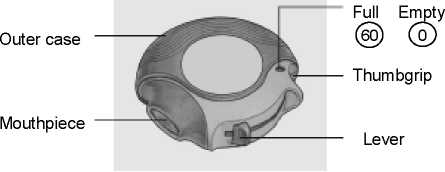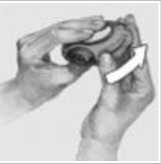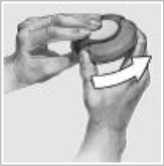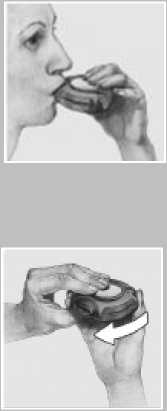Ventolin 200 Micrograms Accuhaler
Counter

Package Leaflet: Information for the User



Read all of this leaflet carefully before you start taking this
medicine because it contains important information for you.
• Keep this leaflet. You may need to read it again.
• If you have any further questions, ask your doctor, nurse or pharmacist.
• This medicine has been prescribed for you only. Do not pass it on to others. It may harm them, even if their signs of illness are the same as yours.
• If you get any side effects, talk to your doctor, nurse or pharmacist. This includes any possible side effects not listed in this leaflet. See section 4.
The name of your medicine is Ventolin"200 micrograms Accuhaler
but will be referred to as Ventolin or Accuhaler throughout this
leaflet.
What is in this leaflet:
1. What Ventolin is and what it is used for
2. What you need to know before you use Ventolin
3. How to use Ventolin
4. Possible side effects
5. How to store Ventolin
6. Contents of the pack and other information
1 What Ventolin is and what it is used for
Ventolin contains a medicine called salbutamol. This belongs to a group of medicines called fast-acting bronchodilators.
• Bronchodilators help the airways in your lungs to stay open.
This makes it easier for air to get in and out.
• They help to relieve chest tightness, wheezing and cough.
Ventolin is used to treat breathing problems in people with asthma and similar conditions. This includes relieving and preventing asthma brought on by exercise or other ‘triggers’. These are things, which bring on asthma symptoms in some people. Common triggers include house dust, pollen, cats, dogs and cigarette smoke.
2 What you need to know before you use Ventolin
Do not use Ventolin if:
• you are allergic to salbutamol sulfate or any of the other ingredients of this medicine (listed in section 6)
• you unexpectedly go into early labour (premature labour) or threatened abortion.
• you have a severe milk-protein allergy.
Warnings and precautions
Talk to your doctor, nurse or pharmacist before taking Ventolin if:
• your asthma is active (for example you have frequent symptoms or flare ups or limited physical ability). Your doctor may start or increase a medicine to control your asthma such as an inhaled corticosteroid
• you have high blood pressure
• you have an overactive thyroid gland
• you have a history of heart problems such as an irregular or fast heart beat or angina
• you are taking xanthine derivatives (such as theophylline) or steroids to treat asthma
• you are taking water tablets (diuretics), sometimes used to treat high blood pressure or a heart condition.
Other medicines and Ventolin
Tell your doctor, nurse or pharmacist if you are taking, have recently taken or might take any other medicines, including medicines obtained without a prescription. This includes herbal medicines. Remember to take this medicine with you if you have to go to hospital.
In particular tell your doctor, nurse or pharmacist if you are taking:
• medicines for an irregular or fast heart beat
• other medicines for your asthma.
Ventolin with food and drink
You can use Ventolin at any time of day, with or without food. Pregnancy, breast-feeding and fertility
If you are pregnant or breast-feeding, think you may be pregnant or planning to have a baby, ask your doctor, nurse or pharmacist for advice before taking this medicine.
Driving and using machines
Ventolin is not likely to affect you being able to drive or use any tools or machines.
Ventolin contains lactose
If you have been told by your doctor that you have an intolerance to some sugars, contact your doctor before taking this medicinal product.
Check with your doctor, nurse or pharmacist if you are not sure.
Adults, adolescents aged 12 years and over and children 4 to 11 years of age
• to relieve asthma - One inhalation (200 micrograms).
• to prevent asthma - One inhalation (200 micrograms) 10 to 15 minutes before exercise or exposure to a ‘trigger’.
• the maximum dose is one inhalation (200 micrograms) four times a day.
Instructions for use
• Your doctor, nurse or pharmacist should show you how to use your inhaler. They should check how you use it from time to time. Not using the Ventolin properly or as prescribed may mean that it will not help your asthma as it should.
• The Ventolin device holds blisters containing Ventolin as a powder.
• There is a counter on top of the Ventolin which tells you how many doses are left. It counts down to 0. The numbers 5 to 0 will appear in red to warn you when there are only a few doses left. Once the counter shows 0, your inhaler is empty.
Do not use your inhaler more often than the doctor told you to. Tell your doctor if your medicine does not seem to be working as well as usual, as your chest problem may be getting worse and you may need a different medicine.
Your doctor may have told you to take more than this as an emergency treatment if your wheezing or breathing gets very bad. It is very important that you keep to your doctor’s instructions as to how many blisters to take and how often to use your inhaler.
Using your inhaler
ITo open your Accuhaler, hold the outer case in one hand and put the thumb of your other hand on the thumbgrip. Push your thumb away from you as far as it will go. You will hear a click. This will open a small hole in the mouthpiece.

If you forget to use Ventolin
2 Hold your Accuhaler with the mouthpiece towards you.
You can hold it in either your right or left hand. Slide the lever away from you as far as it will go. You will hear a click. This places a dose of your medicine in the mouthpiece.

Every time the lever is pushed back a blister is opened inside and the powder made ready for you to inhale. Do not play with the lever as this opens the blisters and wastes medicine.
• If you forget a dose, take it as soon as you remember it
• However, if it is time for the next dose, skip the missed dose
• Do not take a double dose to make up for a forgotten dose.
If you stop using Ventolin
Do not stop using Ventolin without talking to your doctor.
If you have any further questions on the use of this medicine, ask your doctor, nurse or pharmacist.
4 Possible side effects
3 Hold the Accuhaler away from your mouth, breathe out as far as is comfortable. Do not breathe into your Ventolin. Do not breath in again yet.
4 Put the mouthpiece to your lips; breathe in steadily and deeply through the Accuhaler, with your mouth, not through your nose.
Remove the Accuhaler from your mouth.
Hold your breath for about 10 seconds or for as long as is comfortable.
Breathe out slowly.
5 To close the Accuhaler, slide the thumbgrip back towards you, as far as it will go. You will hear a click. The lever will return 1 its original position and is reset. Your Accuhaler is now ready for you to use again.

Cleaning your inhaler
Wipe the mouthpiece of the Accuhaler with a dry tissue to clean it.
If you use more Ventolin than you should
If you use more than you should, talk to a doctor as soon as possible.
The following effects may happen:
• your heart beating faster than usual
• you feel shaky
• hyperactivity.
If your breathing or wheezing gets worse straight after taking this medicine, stop using it immediately, and tell your doctor as soon as possible.
Like all medicines, this medicine can cause side effects, although not everybody gets them. The following side effects may happen with this medicine:
Allergic Reactions (may affect up to 1 in 10,000 people)
If you have an allergic reaction, stop taking Ventolin and see a doctor straight away. Signs of an allergic reaction include: swelling of the face, lips, mouth, tongue or throat which may cause difficulty in swallowing or breathing, itchy rash, feeling faint and light-headed, and collapse.
Talk to your doctor as soon as possible if:
• you feel your heart is beating faster or stronger than usual (palpitations). This is usually harmless, and usually stops after you have used the medicine for a while
• you may feel your heart beat is uneven or it gives an extra beat
• these may affect up to 1 in 10 people.
If any of these happen to you, talk to your doctor as soon as possible. Do not stop using this medicine unless told to do so.
Tell your doctor if you have any of the following side effects, which may also happen with this medicine:
Common (may affect up to 1 in 10 people)
• feeling shaky
• headache.
Uncommon (may affect up to 1 in 100 people)
• mouth and throat irritation
• muscle cramps.
Rare (may affect up to 1 in 1,000 people)
• a low level of potassium in your blood
• increased blood flow to your extremities (peripheral dilatation).
Very rare (may affect up to 1 in 10,000 people)
• changes in sleep patterns and changes in behaviour, such as restlessness and excitability.
The following side effects can also happen but the frequency of these are not known:
• chest pain, due to heart problems such as angina. Tell your doctor, nurse or pharmacist if this occurs. Do not stop using this medicine unless told to do so.
Reporting of side effects
If you get any side effects, talk to your doctor, pharmacist or nurse. This includes any possible side effects not listed in this leaflet. You can also report side effects directly via the Yellow Card Scheme at: www.mhra.aov.uk/vellowcard.
By reporting side effects, you can help provide more information on the safety of this medicine.
If you think this medicine is not working well enough for you
If your medicine does not seem to be working as well as usual, talk to your doctor as soon as possible. Your chest problem may be getting worse and you may need a different medicine. Do not take extra doses of Ventolin unless your doctor tells you to.
Procured from within the EU and repackaged by the Product Licence holder: B&S Healthcare, Unit 4, Bradfield Road, Ruislip, Middlesex, HA4 0NU, UK.
Ventolin® 200 micrograms Accuhaler®; PL 18799/2934
Leaflet date: 07.07.2016
POM
5 How to store Ventolin
• Keep out of the sight and reach of children.
• Do not store above 30°C. Do not freeze.
• Store in the original package in order to protect from light.
• Do not use Ventolin after the expiry date which is stated on the carton and accuhaler label. The expiry date refers to the last day of that month.
• Medicines should not be disposed of via wastewater or household waste. Ask your pharmacist how to dispose of medicines no longer required. These measures will help to protect the environment.
6 Contents of the pack and other information
What Ventolin contains
The active ingredient in Ventolin is salbutamol (as the sulphate). Each dose contains powder for inhalation providing 200 micrograms salbutamol (as the sulphate).
The other ingredient is lactose.
What Ventolin looks like and contents of the pack
The powder for inhalation is contained in blister strips and within a two-tone blue, circular device which has a mouthpiece and dose counter indicating 60 doses.
Each device is packed in cartons which hold: 1 Accuhaler each containing 60 blisters.
Read all of this leaflet carefully before you start taking this
Salbutamol 200 micrograms Accuhaler


medicine because it contains important information for you.
• Keep this leaflet. You may need to read it again.
• If you have any further questions, ask your doctor, nurse or pharmacist.
• This medicine has been prescribed for you only. Do not pass it on to others. It may harm them, even if their signs of illness are the same as yours.
• If you get any side effects, talk to your doctor, nurse or pharmacist. This includes any possible side effects not listed in this leaflet. See section 4.
The name of your medicine is Salbutamol 200 micrograms
Accuhaler but will be referred to as Salbutamol or Accuhaler
throughout this leaflet.
What is in this leaflet:
1. What Salbutamol is and what it is used for
2. What you need to know before you use Salbutamol
3. How to use Salbutamol
4. Possible side effects
5. How to store Salbutamol
6. Contents of the pack and other information
1 What Salbutamol is and what it is used for
Salbutamol contains a medicine called salbutamol. This belongs to a group of medicines called fast-acting bronchodilators.
• Bronchodilators help the airways in your lungs to stay open. This makes it easier for air to get in and out.
• They help to relieve chest tightness, wheezing and cough.
Salbutamol is used to treat breathing problems in people with asthma and similar conditions. This includes relieving and preventing asthma brought on by exercise or other ‘triggers’. These are things, which bring on asthma symptoms in some people. Common triggers include house dust, pollen, cats, dogs and cigarette smoke.
2 What you need to know before you use Salbutamol
Do not use Salbutamol if:
• you are allergic to salbutamol sulfate or any of the other ingredients of this medicine (listed in section 6)
• you unexpectedly go into early labour (premature labour) or threatened abortion.
• you have a severe milk-protein allergy.
Warnings and precautions
Talk to your doctor, nurse or pharmacist before taking Salbutamol if:
• your asthma is active (for example you have frequent symptoms or flare ups or limited physical ability). Your doctor may start or increase a medicine to control your asthma such as an inhaled corticosteroid
• you have high blood pressure
• you have an overactive thyroid gland
• you have a history of heart problems such as an irregular or fast heart beat or angina
• you are taking xanthine derivatives (such as theophylline) or steroids to treat asthma
• you are taking water tablets (diuretics), sometimes used to treat high blood pressure or a heart condition.
Other medicines and Salbutamol
Tell your doctor, nurse or pharmacist if you are taking, have recently
taken or might take any other medicines, including medicines
obtained without a prescription. This includes herbal medicines.
Remember to take this medicine with you if you have to go to
hospital.
In particular tell your doctor, nurse or pharmacist if you are taking:
• medicines for an irregular or fast heart beat
• other medicines for your asthma.
Always use this medicine exactly as your doctor has told you.
Check with your doctor, nurse or pharmacist if you are not sure.
Adults, adolescents aged 12 years and over and children 4 to 11 years of age
• to relieve asthma - One inhalation (200 micrograms).
• to prevent asthma - One inhalation (200 micrograms) 10 to 15 minutes before exercise or exposure to a ‘trigger’.
• the maximum dose is one inhalation (200 micrograms) four times a day.
Instructions for use
• Your doctor, nurse or pharmacist should show you how to use your inhaler. They should check how you use it from time to time. Not using the Salbutamol properly or as prescribed may mean that it will not help your asthma as it should.
• The Salbutamol device holds blisters containing Salbutamol as a powder.
• There is a counter on top of the Salbutamol which tells you how many doses are left. It counts down to 0. The numbers 5 to 0 will appear in red to warn you when there are only a few doses left. Once the counter shows 0, your inhaler is empty.
Do not use your inhaler more often than the doctor told you to. Tell your doctor if your medicine does not seem to be working as well as usual, as your chest problem may be getting worse and you may need a different medicine.
Your doctor may have told you to take more than this as an emergency treatment if your wheezing or breathing gets very bad. It is very important that you keep to your doctor’s instructions as to how many blisters to take and how often to use your inhaler.
Using your inhaler

ITo open your Accuhaler, hold the outer case in one hand and put the thumb of your other hand on the thumbgrip. Push your thumb away from you as far as it will go. You will hear a click. This will open a small hole in the mouthpiece.
Salbutamol with food and drink
You can use Salbutamol at any time of day, with or without food. Pregnancy, breast-feeding and fertility
If you are pregnant or breast-feeding, think you may be pregnant or planning to have a baby, ask your doctor, nurse or pharmacist for advice before taking this medicine.
Driving and using machines
Salbutamol is not likely to affect you being able to drive or use any tools or machines.
Salbutamol contains lactose
If you have been told by your doctor that you have an intolerance to some sugars, contact your doctor before taking this medicinal product.
If you forget to use Salbutamol
2 Hold your Accuhaler with the mouthpiece towards you.
You can hold it in either your right or left hand. Slide the lever away from you as far as it will go. You will hear a click. This places a dose of your medicine in the mouthpiece.

Every time the lever is pushed back a blister is opened inside and the powder made ready for you to inhale. Do not play with the lever as this opens the blisters and wastes medicine.
• If you forget a dose, take it as soon as you remember it
• However, if it is time for the next dose, skip the missed dose
• Do not take a double dose to make up for a forgotten dose.
If you stop using Salbutamol
Do not stop using Salbutamol without talking to your doctor.
If you have any further questions on the use of this medicine, ask your doctor, nurse or pharmacist.
4 Possible side effects
3 Hold the Accuhaler away from your mouth, breathe out as far as is comfortable. Do not breathe into your Salbutamol. Do not breath in again yet.
4 Put the mouthpiece to your lips; breathe in steadily and deeply through the Accuhaler, with your mouth, not through your nose.
Remove the Accuhaler from your mouth.
Hold your breath for about 10 seconds or for as long as is comfortable.
Breathe out slowly.
5 To close the Accuhaler, slide the thumbgrip back towards you, as far as it will go. You will hear a click. The lever will return 1 its original position and is reset. Your Accuhaler is now ready for you to use again.

Cleaning your inhaler
Wipe the mouthpiece of the Accuhaler with a dry tissue to clean it.
If you use more Salbutamol than you should
If you use more than you should, talk to a doctor as soon as possible.
The following effects may happen:
• your heart beating faster than usual
• you feel shaky
• hyperactivity.
If your breathing or wheezing gets worse straight after taking this medicine, stop using it immediately, and tell your doctor as soon as possible.
Like all medicines, this medicine can cause side effects, although not everybody gets them. The following side effects may happen with this medicine:
Allergic Reactions (may affect up to 1 in 10,000 people)
If you have an allergic reaction, stop taking Salbutamol and see a doctor straight away. Signs of an allergic reaction include: swelling of the face, lips, mouth, tongue or throat which may cause difficulty in swallowing or breathing, itchy rash, feeling faint and light-headed, and collapse.
Talk to your doctor as soon as possible if:
• you feel your heart is beating faster or stronger than usual (palpitations). This is usually harmless, and usually stops after you have used the medicine for a while
• you may feel your heart beat is uneven or it gives an extra beat
• these may affect up to 1 in 10 people.
If any of these happen to you, talk to your doctor as soon as possible. Do not stop using this medicine unless told to do so.
Tell your doctor if you have any of the following side effects, which may also happen with this medicine:
Common (may affect up to 1 in 10 people)
• feeling shaky
• headache.
Uncommon (may affect up to 1 in 100 people)
• mouth and throat irritation
• muscle cramps.
Rare (may affect up to 1 in 1,000 people)
• a low level of potassium in your blood
• increased blood flow to your extremities (peripheral dilatation).
Very rare (may affect up to 1 in 10,000 people)
• changes in sleep patterns and changes in behaviour, such as restlessness and excitability.
The following side effects can also happen but the frequency of these are not known:
• chest pain, due to heart problems such as angina. Tell your doctor, nurse or pharmacist if this occurs. Do not stop using this medicine unless told to do so.
Reporting of side effects
If you get any side effects, talk to your doctor, pharmacist or nurse. This includes any possible side effects not listed in this leaflet. You can also report side effects directly via the Yellow Card Scheme at: www.mhra.aov.uk/vellowcard.
By reporting side effects, you can help provide more information on the safety of this medicine.
If you think this medicine is not working well enough for you
If your medicine does not seem to be working as well as usual, talk to your doctor as soon as possible. Your chest problem may be getting worse and you may need a different medicine. Do not take extra doses of Salbutamol unless your doctor tells you to.
Procured from within the EU and repackaged by the Product Licence holder: B&S Healthcare, Unit 4, Bradfield Road, Ruislip, Middlesex, HA4 0NU, UK.
Salbutamol 200 micrograms Accuhaler; PL 18799/2934
Leaflet date: 07.07.2016
POM
5 How to store Salbutamol
• Keep out of the sight and reach of children.
• Do not store above 30°C. Do not freeze.
• Store in the original package in order to protect from light.
• Do not use Salbutamol after the expiry date which is stated on the carton and accuhaler label. The expiry date refers to the last day of that month.
• Medicines should not be disposed of via wastewater or household waste. Ask your pharmacist how to dispose of medicines no longer required. These measures will help to protect the environment.
6 Contents of the pack and other information
What Salbutamol contains
The active ingredient in Salbutamol is salbutamol (as the sulphate). Each dose contains powder for inhalation providing 200 micrograms salbutamol (as the sulphate).
The other ingredient is lactose.
What Salbutamol looks like and contents of the pack
The powder for inhalation is contained in blister strips and within a two-tone blue, circular device which has a mouthpiece and dose counter indicating 60 doses.
Each device is packed in cartons which hold: 1 Accuhaler each containing 60 blisters.